Seahawks Analysis: 4 Ways QB Geno Smith, Offense Can Improve
On the path to an unexpected playoff berth behind resurgent quarterback Geno Smith, the Seattle Seahawks put up gaudy individual and team numbers on the offensive side of the ball in 2022.
For his part, earning Comeback Player of the Year honors and his first Pro Bowl selection, Smith led the NFL in completion rate, finished in the top five in passing touchdowns (30), and tied for the NFL lead with 12 games throwing multiple touchdown passes. Running back Ken Walker III became only the second rookie in Seahawks franchise history to rush for over 1,000 yards, while receivers Tyler Lockett and DK Metcalf each eclipsed 1,000 yards in the same season for the second time, helping the team finish ninth in scoring offense.
But while Seattle's offense soared much higher than expected in the aftermath of trading star quarterback Russell Wilson, the unit wasn't without flaws and there's still tons of room for improvement. Notably, the team only finished 13th in total yards and ranked 20th in rushing yards, well below expectations under coach Pete Carroll.
Personnel wise, the Seahawks further stacked the deck around Smith, who received his own three-year contract extension, by drafting receiver Jaxon Smith-Njigba in the first round to pair with Metcalf and Lockett along with snagging running back Zach Charbonnet in the second round to join forces with Walker in the backfield. In addition, they signed center Evan Brown to replace retiring Austin Blythe with hopes of bolstering the middle of the offensive line.
Reflecting on their 2022 season, with expectations sky high moving into a new campaign, here's a close look at four key areas where Smith and the Seahawks must improve to fly to their ceiling as one of the NFL's most potent all-around attacks.
1. More Productive Early-Down Rushing
With Carroll at the helm, the Seahawks value running the football as much as any team in today's NFL. But while Ken Walker III burst onto the scene as a 1,000-yard rusher and Offensive Rookie of the Year finalist, the team struggled to run the ball effectively on early downs, especially in the second half of the 2022 season.
Looking at the season as a whole, Seattle finished seventh in the league in yards per carry. This statistic suggests the team was more than effective enough running the ball, but it is a bit misleading for several reasons.
For one, Smith surprised with his mobility and ability to create with his legs as a scrambler, rushing for 306 yards and averaging a healthy 5.4 yards per carry. Those numbers skew the Seahawks per carry numbers a bit, as much of his rushing yardage came on broken down plays rather than designed quarterback runs.
Secondly, based on advanced metrics, the Seahawks struggled to yield positive plays in the run game on early downs. According to RBSDM.com, while the team ranked a respectable 13th in rushing EPA (expected points added), they ranked dead last in first down rushing success rate at an abysmal 28.6 percent. They weren't any better on second down, ranking 27th in rushing EPA and success rate at 38.3 percent.
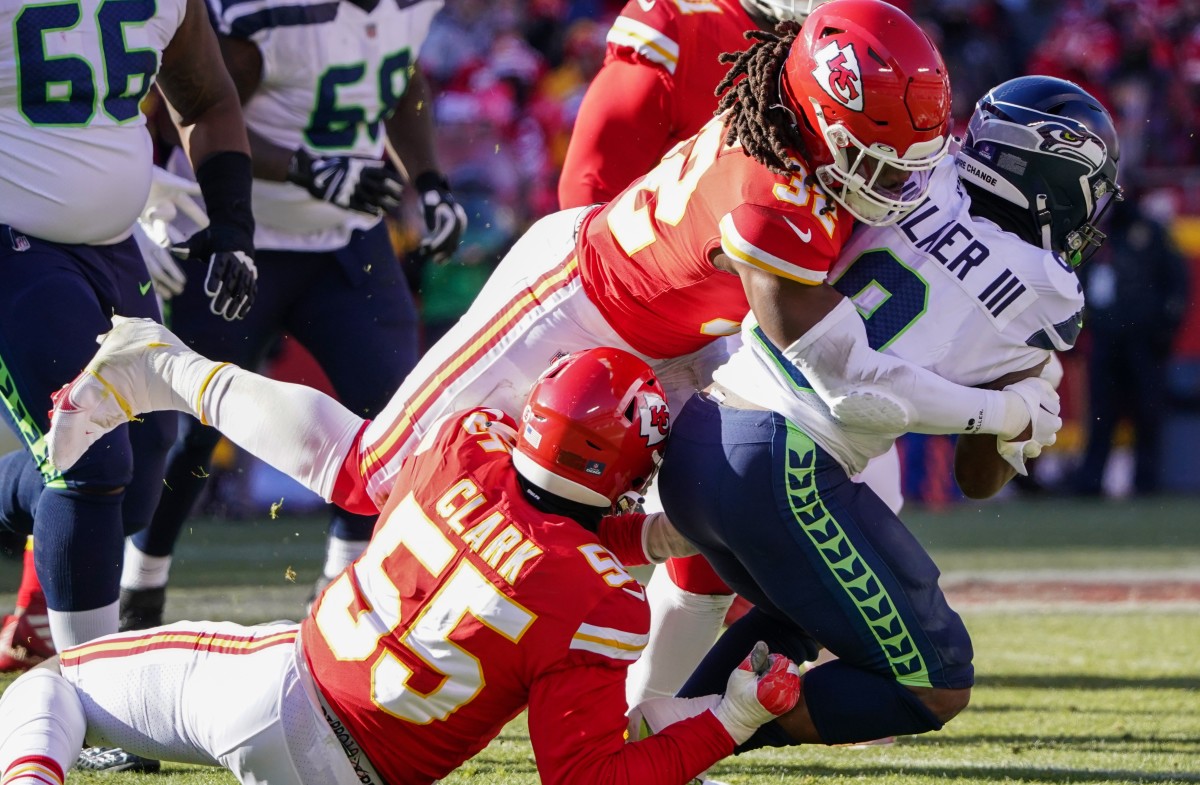
In some ways, Seattle proved to be even more inept running the ball on early downs in the second half and those struggles coincided with the team slumping down the stretch, including losing five out of six games at one point. Unable to consistently produce positive yards running the ball on early downs, Carroll's squad ranked 21st and 27th in rushing EPA on first and second down respectively. They were 20th in success rate (28.6 percent) on first down and only slightly better with an 18th overall ranking on second down (41.7 percent).
While those numbers hint that the Seahawks should have ran less on early downs, sample size has to be considered. For example, they only ran the ball 14 times per game in losses to the Panthers and 49ers in December, and as Carroll bemoaned after both games, the inability to get enough carries on the ground factored into the defeats with the offense scuffling in both contests.
Thinking big picture, with an offensive line that finished the season ranked 18th in run block grade by Pro Football Focus, tied for 16th in run block win rate by ESPN, and ranked 30th in adjusted line yards by Football Outsiders, Seattle's struggles creating push off the line of scrimmage led to far too many early down runs that netted zero or negative yards, including five negative runs in a loss to the Chiefs in Kansas City. These plays put the offense behind the sticks and off schedule, contributing to poor third down performance and ultimately limiting touches for Walker and company.
For the Seahawks to reach their full potential offensively in 2023, they will have to be more effective with first and second down rush attempts to set up more favorable third downs and allow for sustained drives. Walker and Charbonnet should give them one of the best one-two punches in the league, but blocking will have to take a step forward for them to perform at their best and take a load off of Smith's shoulders.
2. Improved Third-Down Efficiency
Speaking of third downs, though Seattle's woes running the ball on early downs did put Smith and the offense in difficult 3rd-and-long situations way too often, that was only part of the problem that led to a 20th overall ranking in third down conversion and success rate.
In the passing department, per RBSDM.com, Smith dominated on first down, ranking first in completion rate (77.8 percent), completion percentage above expectation (8.2 percent), and sixth in success rate (55.6 percent). Statistically, he finished in the top five in success rate, completion rate, and completion percentage above expectation on first and second down, which played a key role in winning Comeback Player of the Year honors in a breakout season.
However, Smith was a middling signal caller at best on third down all season long. While he still ranked seventh in completion rate (65.6 percent), his success rate plunged to 38.8 percent, barely ahead of Patriots quarterback Mac Jones and ranking a dismal 23rd out of 32 qualified players. He also dipped down to 17th in EPA per play, ranking behind the likes of Jacoby Brissett and Kenny Pickett.
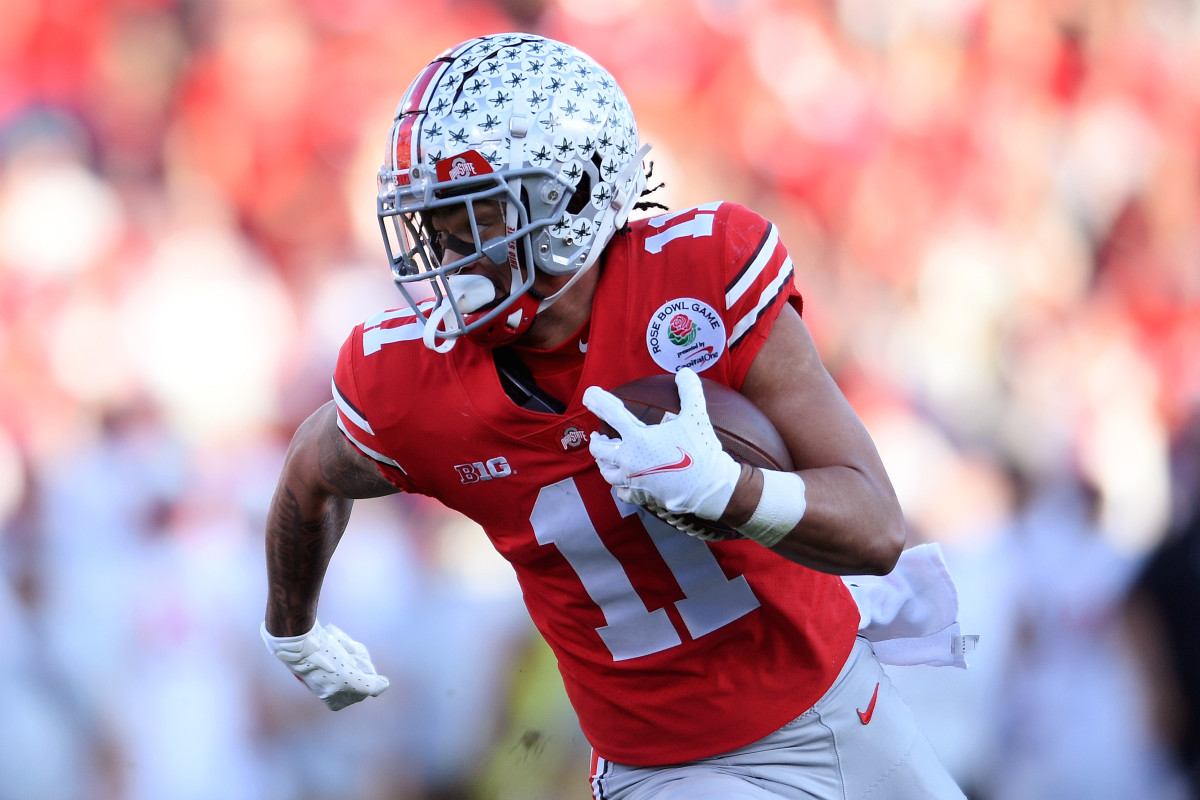
These issues were magnified as the Seahawks stumbled in the second half and dipped to 27th in third down success rate in that span (36 percent), as Smith ranked 28th in EPA per play, 30th in success rate (34.9 percent), and posted a much lower 60.9 percent completion rate. In his defense, some of this regression stemmed from pass protection issues - more on that later - and the fact the team's average third down yardage to go nearly jumped a full yard per play in the final eight games.
Consistently facing more difficult third downs to convert further from the sticks, according to Pro Football Reference, it's no wonder Seattle's third down conversion rate nosedived from north of 45 percent in the first half to a league-worst 28.1 percent in the final eight games.
As elaborated on the earlier point about first and second down run game woes, this is a multi-faceted problem that isn't as simple as Smith completing five percent more of his passes on third down. For the Seahawks to truly take off as one of the NFL's elite offenses this year, they need to put themselves in more ideal situations on third down with shorter yardage to go, a responsibility that falls on Smith, the offensive line, coordinator Shane Waldron, and everyone on the offensive side of the ball.
3. Progression in Pass Protection Up Front
Whenever an offense fails to produce or meet expectations, whether fair or not, the offensive line often becomes the scapegoat. In the case of the Seahawks and their decline down the stretch, the front line deserves some of the blame, but they certainly weren't the lone culprit either.
From a comparative standpoint, with two rookies in Charles Cross and Abraham Lucas starting at the tackle spots, Seattle's youthful starting offensive line allowed 13 sacks, 76 quarterback pressures, and 15 quarterback hits in the first nine games. Per Pro Football Focus, four of their five starters posted a pass blocking efficiency rate north of 97 percent.
Over the final eight games, including numbers from one spot start by Stone Forsythe at right tackle and a platoon between Gabe Jackson and Phil Haynes at right guard, the Seahawks allowed 13 sacks, 83 pressures, and 15 quarterback hits, equaling or surpassing numbers in each category in one less game. Only two starters posted pass blocking efficiency rates above 97 percent, a clear sign of regression for the unit.
Interestingly, however, PFF credited Seattle's offensive line for responsibility on 81.8 percent of pressures in the first half. That number dropped nearly five whole percent to 76.6 percent in the final eight games.
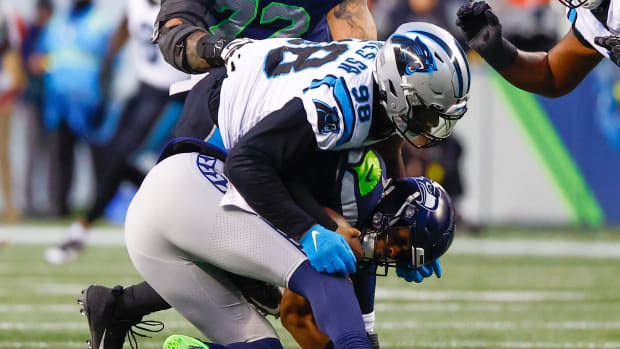
What's behind that stark difference? While there's subjectivity to assessing pressures and PFF charting shouldn't be viewed as the end-all, be-all, quarterbacks do play a role in pressure with how long they hold onto the ball and accounting for extra unblocked rushers. In the case of Smith, after only being credited with three sacks in the first nine games, he was charged with responsibility for eight sacks in the final eight games, suggesting he deserves some brunt of the blame.
Heading into 2023, the Seahawks believe their offensive line will be better across the board and such optimism seems warranted. With a full year of experience under their belts, Cross and Lucas should take a big step in their sophomore seasons, while Brown and rookie Olu Oluwatimi should be upgrades over Blythe at center and Phil Haynes and rookie Anthony Bradford offer more upside than an aging, banged-up Gabe Jackson did at right guard.
With that said, there are still plenty of unknowns with two new starters expected in the interior and the potential for those spots to be filled by rookies. Like any quarterback in the league, Smith can help himself stay clean by improving at getting the ball out of his hands a tad quicker and in addition, Waldron can aid the process with how he calls plays to mitigate pass rushes.
4. Cut Down on Turnovers, Particularly in Own Territory
It's hard enough to beat NFL teams without throwing interceptions or coughing up fumbles, but the Seahawks further complicated efforts by enduring one of their worst seasons in the turnover category in recent memory.
Dating back to Carroll's arrival in 2010, Seattle's 25 turnovers in the regular season and playoffs stands out as the second-highest total for the franchise during that span. Painting an even bleaker picture, those turnovers led to points for the opposition 68 percent of the time, the third-worst turnover to points rate in the NFL last season.
Digging into specifics, the Seahawks committed 15 turnovers in their own territory, the most in the NFL, including a pick six thrown by Smith in a win over the Cardinals in Arizona and a botched punt attempt recovered in the end zone against the Cardinals in Seattle. Excluding those two defensive scores, Seattle allowed eight touchdowns, including five on drives lasting two or fewer plays, and three field goals.
There's no such thing as a positive turnover, but several of these miscues proved crucial in close defeats and couldn't have occurred at worse times.
In Week 5, only two plays into the second half with the Seahawks nursing a two-point lead over the Saints, DK Metcalf fumbled deep in opposing territory, setting up a touchdown drive for the home team. In Week 11, a bad pick by Smith gave way to a 30-yard touchdown by Raiders running back Josh Jacobs on the next play. Then in Week 15, Travis Homer fumbled the team's momentum away late in the first half, allowing the 49ers to punch in a touchdown before half.
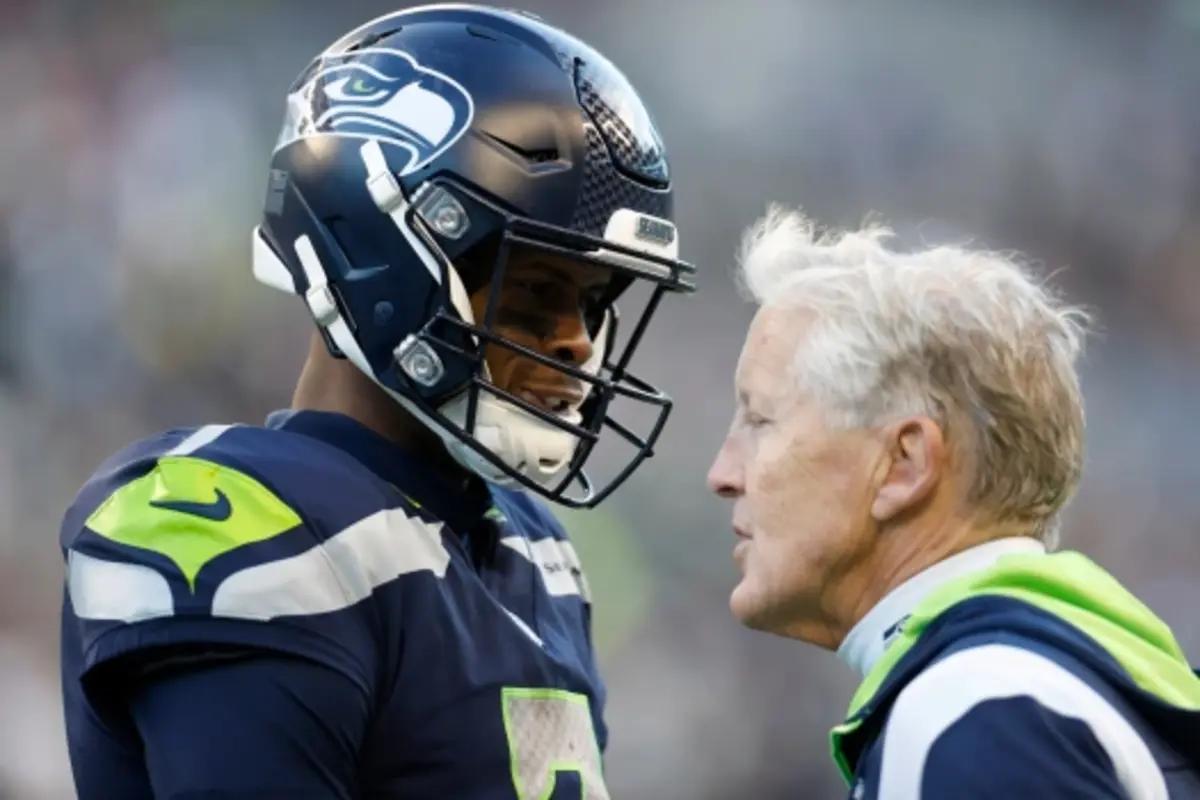
All three of those games wound up being one-score losses and if those turnovers didn't happen to gift wrap easy touchdowns for the opposition, Seattle likely would have won at least one of those contests and wouldn't have had to sweat things out in the final week in the playoff race. Instead, they allowed 91 points off turnovers, the most among NFL teams who qualified for the postseason.
Given the minimal margin for error in the league, the Seahawks will need Smith to cut down on his mistakes, as he accounted for 17 of those 25 turnovers with 12 interceptions and five lost fumbles. Waldron also needs to make sure to remove any trick plays asking DeeJay Dallas to throw the football out of a four-back personnel grouping from the playbook and light them on fire.
If those two areas are cleaned up, Seattle should be positioned to make major strides in the turnover department that plagued it last year. Even if the number only goes down by four or five in comparison, that could be all the difference in winning an extra couple games and potentially winning an NFC West title.
Want the latest in breaking news and insider information on the Seahawks? Click Here to subscribe to AllSeahawks.com's Newsletter.
Follow All Seahawks.com on Twitter and Facebook
Make sure to subscribe to our daily podcast @lockedonseahawks today! Click here To Listen.
Want even more Seattle Seahawks news? Check out the SI.com team page here.
